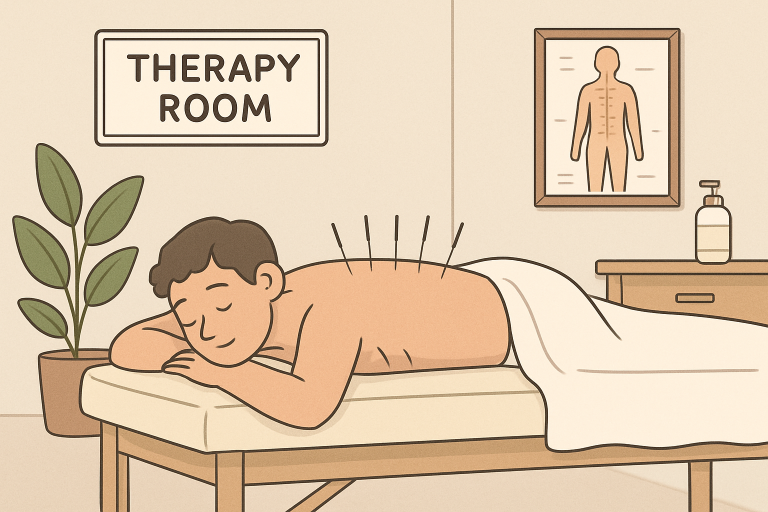Key Takeaways:
- Acupuncture is increasingly recognized as an effective method for managing various types of pain.
- Scientific studies support its efficacy in reducing chronic pain conditions.
- Integrating acupuncture with conventional treatments can enhance overall pain management strategies.
Table of Contents
Introduction
Modern pain management has expanded far beyond pharmaceuticals, with acupuncture emerging as one of the most promising holistic approaches. Increasing numbers of people across the United States—and particularly in urban areas—seek evidence-based, non-pharmacological options for relief. For those interested in acupuncture for pain management in Los Angeles, the integration of traditional Chinese medicine with Western healthcare offers a personalized and comprehensive pathway to pain relief.
Acupuncture has roots that reach back thousands of years, yet its recent resurgence underscores its contemporary relevance. Chronic pain is often resistant to conventional solutions, prompting physicians and patients to look toward complementary therapies. The growing demand reflects acupuncture’s reputation for safety, effectiveness, and its minimal risk of side effects—a combination increasingly valued in today’s healthcare landscape.
Through ongoing research and clinical integration, acupuncture has gained recognition not only for its pain-relieving properties but also as a tool for promoting overall well-being. Many leading hospitals and pain clinics now incorporate acupuncture into comprehensive management plans, guided by the belief that collaborative care yields the best results in managing chronic pain. This collaborative, patient-centered approach represents a significant shift in how healthcare providers address persistent pain.
As you explore acupuncture as part of your personal or professional pain management journey, it’s essential to understand how the treatment works and the scientific support backing its use. Whether you’ve been living with pain for years or are simply curious about complementary therapies, the following sections detail how acupuncture can contribute to a healthier, more comfortable life.
Understanding Acupuncture
Acupuncture is a central component of Traditional Chinese Medicine (TCM), focusing on achieving balance and flow within the body’s energy pathways, known as meridians. Practitioners insert ultra-fine needles at targeted points, known as acupoints, to stimulate the body’s intrinsic healing processes. While this may sound mystical, research now shows that these interventions promote various physiological changes, including the release of natural painkillers such as endorphins, enhanced blood flow, and reduced inflammation.
Sessions are typically relaxing, with minimal discomfort. Proper needle placement is generally painless for most people, and a sense of calm and relief often sets in quickly. Acupuncture’s blending of art and science has made it a natural partner to modern medicine, with researchers working to decode why and how this practice works so effectively for pain management.

Scientific Evidence Supporting Acupuncture
Robust scientific research supports the recent rise in acupuncture’s popularity. It has shown to offer significant relief for chronic pain conditions, such as back, neck, and osteoarthritis pain, outperforming standard care and even “sham” treatments. These findings strengthen the case for acupuncture’s legitimacy in clinical settings, indicating that its effects are likely not just placebo responses.
Notably, the World Health Organization also recognizes acupuncture as an effective intervention for chronic pain. Its physiological effects include modulation of neurotransmitters and anti-inflammatory effects, documented in both clinical and laboratory settings. These studies contribute to the widespread acceptance of acupuncture as more than an ancient ritual, but rather a science-backed medical treatment.
Acupuncture in Modern Medicine
Today’s healthcare systems are under increasing pressure to provide safe, effective, and affordable pain management options. Acupuncture is now integrated into hospital pain clinics, rehabilitation centers, and primary care offices. This integration is critical as the medical community seeks alternatives to opioid prescriptions, given the ongoing epidemic of opioid misuse and dependency.
The respect for acupuncture amongst medical professionals continues to grow, with referral networks and multidisciplinary pain teams frequently incorporating licensed acupuncturists.
Conditions Treated by Acupuncture
Acupuncture has demonstrated success in addressing a broad array of pain conditions, which include:
- Chronic back and neck pain
- Osteoarthritis and joint pain
- Migraines and tension headaches
- Fibromyalgia and myofascial pain
- Menstrual cramps and pelvic pain
Its personalized approach allows for treatment plans tailored not just to the diagnosis but to the unique expression of pain in each patient. This versatility is one reason why acupuncture is embraced as a core aspect of modern pain management protocols.
What to Expect During an Acupuncture Session
The initial session typically begins with a comprehensive assessment of a patient’s medical history, lifestyle, and pain patterns. Practitioners then select specific acupoints, insert sterilized needles, and leave them in for 20-30 minutes. Most people describe the sensation as mildly tingling or warming. Sessions are generally very relaxing, sometimes even inducing a meditative state.
Treatment plans are customized and often consist of weekly or biweekly visits over several weeks. Many patients experience a cumulative benefit, with significant pain relief emerging after a series of sessions. A qualified acupuncturist will also recommend lifestyle or dietary adjustments to enhance long-term outcomes.
Safety and Considerations
Acupuncture is widely considered safe when performed by a well-trained, licensed practitioner using sterile, single-use needles. Adverse effects are uncommon but can include slight bruising or soreness at needle sites. Acupuncture may also provide benefits for certain pain conditions and overall wellness when applied correctly. Patients who are pregnant, have bleeding disorders, or use blood thinners should inform their practitioner prior to treatment. It’s always advisable to ensure your provider holds appropriate state licensure and has experience working with your specific pain condition.
Conclusion
Acupuncture’s blend of ancient tradition and modern medical validation makes it an essential option for anyone seeking relief from chronic pain. Its rising acceptance within mainstream healthcare, supported by robust scientific evidence, positions acupuncture as a vital tool in comprehensive pain management strategies. For individuals seeking effective, low-risk alternatives to pharmaceuticals, acupuncture offers a holistic, personalized path to lasting comfort and well-being.
The Editorial Team at Healthcare Business Today is made up of experienced healthcare writers and editors, led by managing editor Daniel Casciato, who has over 25 years of experience in healthcare journalism. Since 1998, our team has delivered trusted, high-quality health and wellness content across numerous platforms.
Disclaimer: The content on this site is for general informational purposes only and is not intended as medical, legal, or financial advice. No content published here should be construed as a substitute for professional advice, diagnosis, or treatment. Always consult with a qualified healthcare or legal professional regarding your specific needs.
See our full disclaimer for more details.







